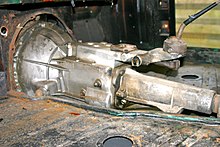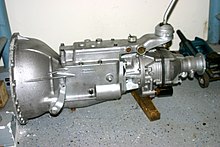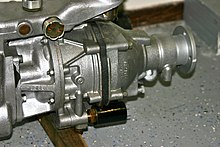Overdrive (transmission)
Overdrive is the name of an early passage in the motor vehicle - transmission , which causes a lowering of the necessary for a particular speed engine speed (with thereby increased torque requirement). Overdrive is a registered trademark of BorgWarner Corporation .
function
In a narrower sense, overdrive refers to a planetary gear connected downstream of the normal gearbox in its own housing, which is connected electrically or manually - mostly to third and fourth gear. The overdrive reduces the input speed - and thus the engine speed - at the same output speed and vehicle speed - for example by 22 percent on some Triumph and MG models or by 28 percent on some Austin-Healey 3000 and Jaguar types; at 130 km / h, this reduction in speed can be in the order of magnitude of 1000 revolutions per minute. The reduced piston speed reduces the loads on the engine. Background noise and fuel consumption can also be reduced in this way, but the maximum speed that can be achieved on the flat is reduced.
The simple insertion at the switch is advantageous; however, customers of the Opel and Ford brands in particular considered the operation to be too cumbersome. Above all, however, it enables manufacturers to offer a gentle cycle without major development effort. The switch was on the steering column or in the gear lever.
In American GM vehicles, the automatic had the shift position “O” between “N” and “D”. This should be used instead of "D" if the vehicle is not pulling any heavy trailers and there is no constant load change. In this switch position, the overdrive is automatically activated from a speed of approx. 70 km / h or 40 mph if no high torque is transmitted. The overdrive cannot transmit high torques. It represents a fifth gear of a manual gearbox within the automatic transmission with reduced oil pressure loss. For this purpose, the speed on the speedometer cable in the cruise control and the vacuum from the intake manifold are scanned with a vacuum switch in order to switch on the pull magnet of the overdrive when required. The switch position "D" deactivates this circuit and thus the overdrive. The accelerator pedal and cruise control are designed in such a way that you can dose very precisely between idle and lower partial load. The overdrive is only switched off when it can no longer be avoided. With this function, the small blocks (engine blocks with cylinder bores around 100 mm (4 ")) could be kept at speeds between 90 and 110 km / h with a consumption of 11.5 l per 100 km.
history
development
In the 1950s and 1960s, the Laycock overdrive by the inventor Edgar Joseph de Normanville (1884–1968) was relatively common in English sedans and sports cars as an option to order in the performance class between 60 and 150 hp. The standard four-speed gearbox often did not allow a fifth gear to be installed, but a reduction in the number of revolutions when driving overland in the growing motorway network and consequently higher travel speeds was increasingly desired. An overdrive planetary stage could be attached to an existing gearbox construction quite easily: with a longer housing on the cardan shaft flange for the planetary gear stage, with a slightly shorter cardan shaft and an electrical switch to operate the magnetic valve-controlled and oil-pressure operated band brake of the planetary ring, the overdrive was quite inexpensive to build. However, the maximum torque had to be taken into account: in the lower, "stronger" gears, an overdrive is overwhelmed with the holding forces, so it can only be operated in top gear or only in third and fourth gear.
Current
Today's vehicle transmissions usually have one or two longer gears, so that a downstream overdrive transmission is no longer necessary. In the 1950s and 1960s, on the other hand, the overdrive transmission was widely used, especially by Volvo and English manufacturers. Opel offered it for a short time in the Opel Kapitän , Rekord E1 and Commodore C models . Ford offered it for a short time in the Taunus 17m (P2) . However, this special equipment was discontinued after a short time due to lack of demand, which was due to the somewhat cumbersome operation.
For the subsequent "full equipping" of classic cars, retrofitting a previously missing overdrive is still common practice if this special equipment was available for the vehicle type in question.
An overdrive gearbox was offered as standard in almost all US vehicles from GM from 1982 to meet the strict American consumption standards. Travel consumption at a moderate motorway speed is then around 10 liters / 100 km, on country roads it is 9 liters, and the 15-liter mark can hardly be reached even in winter in city traffic. The overdrive also appeared at Ford and was offered in the vehicle models Lincoln Town Car, Mercury Grand Marquis, Ford Crown Victoria (sold until 2007, from then only as a fleet vehicle), and of course from GM until recently in the Cadillac DTS. The overdrive added a four-speed automatic transmission; all models mentioned have a V-8 engine and expired in 2011. GM also built a very low rated engine speed with the 5.7 liter LT1, which was offered in the luxury class (Cadillac Fleetwood, Buick Roadmaster, Chevrolet Caprice Classic and Impala SS) from 1994 to 1996 and only ran at 100 km / h Has 1,370 revolutions; at the governed top speed of 175 km / h it is 2,400 revolutions / min. GM currently still offers a six-speed transmission with overdrive in the Buick LaCrosse. It is offered as a free alternative to the “normal” six-speed gearbox and can only be ordered with e-Assist four-cylinder engines.
Manufacturer and licensee
Laycock is an important manufacturer. In the past, the Adlerwerke manufactured corresponding gearboxes under license.
Similar concepts
The APA (Additional Powertrain Adjustment) transmission developed by the Cetoni company in the 1990s works in a similar way to a classic overdrive transmission . It is a two-speed, synchronized additional gear that works as a reduction or transmission gear, depending on the installation direction. The shift works electro-hydraulically and is operated by a small switch on the gear lever. When using the APA gearbox, twice as many gear steps are available as with the standard manual gearbox. It can be used in almost every rear-wheel drive and also in many all-wheel drive vehicles to increase either the top speed or the tractive effort.
Terminology
In the DIN standard 70023 "Designation of individual motor vehicle parts" of April 1954, the following types of gear are listed under the additional gearboxes: "Mountain gear", "Economy gear" and "Overdrive gear" (not "high-speed gear"). The accompanying sheet from April 1958 contains the following English translations: "overdrive" for economy gear and overdrive gear and "hill gear" for mountain gear. Today, the term overdrive is often used in vehicle tests and product descriptions for very long gears. It is also used for gears that are not translated into slow, but rather fast.
literature
- Overdrive as a gentle and economical gear. In: Motor Vehicle Technology 8/1958, pp. 308-309.



